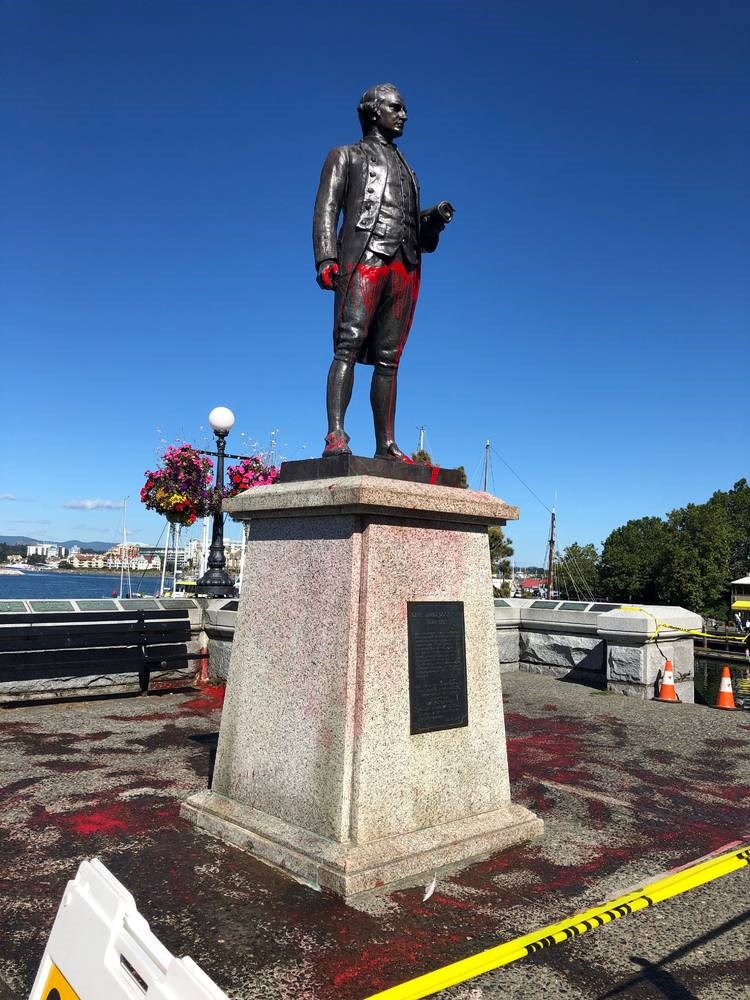B.C. historians say vandalism that targeted the statue of British explorer Capt. James Cook in the Inner Harbour raises questions about whether such monuments glorify figures who represent oppression of Indigenous people.
On Thursday morning, someone splashed the life-size statue with red oil paint, which covered the statue’s legs and right hand holding a compass. Paint also stained the pavement surrounding the statue, which faces the Fairmont Empress Hotel.
No one has claimed responsibility for the vandalism, but amid anti-Black-racism protests this summer, statues of explorers and political and military leaders that are seen as symbols of colonialism, slavery and oppression have been vandalized and toppled.
Cook sailed along the west coast of Canada during his third voyage of discovery in 1778, anchoring in Nootka Sound while seeking a northern route from the Pacific to the Atlantic. He also made the first European contact with the eastern coastline of Australia and the Hawaiian Islands and completed the first recorded circumnavigation of New Zealand. He was killed in 1779 during a skirmish with Hawaiian warriors.
Dr. Reuben Rose-Redwood, a professor of geography with the University of Victoria, said as Cook mapped many of the places he visited, he renamed places, “and in the process, wiped out Indigenous names from the map. So in a very real sense, Cook and his crew, his cartographers, are responsible for the dispossession of Indigenous place names around the world.”
Rose-Redwood said he was not surprised to learn about the vandalism.
“I do think this form of direct action is trying to make a political statement to raise awareness about the fact that statues, monuments and place names have long told a particular narrative of history, by placing European colonizers up on a pedestal,” Rose-Redwood said.
Another statue of Cook in Cairns, Australia, is also the subject of fierce debate. A petition with 15,000 signatures calls for the removal of the statue, which they say symbolizes Australia’s brutal oppression against Aboriginal people.
There has also been a movement to rename the Cook Islands, named after Cook, to reflect Polynesian heritage.
Dr. Lorne Hammond, curator of history at the Royal B.C. Museum, said Cook might be connected to European colonialism, but he also made an undeniable contribution to B.C. history.
“I can understand why someone would have that strong reaction to what they saw as a heroic image of someone who is responsible for tremendous dispossession and hardship for Indigenous people,” Hammond said.
However, Hammond said Cook should also be remembered as one of the most important seafarers in history, who travelled around the world three times and sailed every ocean except the Arctic.
Cook was the first British explorer to visit dozens of Indigenous communities across the Pacific Northwest, Hammond said, which was documented through the drawings of the artist who accompanied him, John Webber.
“Before cameras, these are the first images of the interior of long houses, the first — quite respectful — images of chiefs and senior women with in the matrilineal society,” Hammond said.
Cook’s team also produced the first scientific records of botany samples and collected samples of Indigenous weavings from communities across the Pacific, one of which is kept in the museum’s archives, he said.
“A lot of the world’s knowledge of Indigenous people and the coast of British Columbia does come from Cook,” he said. “But we can’t divorce colonialism from that either.”
The Captain Cook statue was commissioned by the Victoria Environmental Enhancement Society and unveiled by former B.C. premier Bill Bennett on July 12, 1976 to mark the 200th anniversary of Cook’s departure from Plymouth, England, on the voyage that brought him to Vancouver Island. At the time, the Nuu-chah-nulth people, on whose territories Cook first landed, made it clear they would not be attending the statue unveiling, said Victoria historian John Adams.
“There were people at that time who said maybe we shouldn’t be celebrating him,” Adams said.
The statue is owned by the Greater Victoria Harbour Authority and sits on its property.
Ian Robertson, CEO of the harbour authority, said he’s disappointed by the vandalism and prefers dialogue to destruction of private property.
“I’m happy to have an objective, calm, rational discussion with anyone who wants to provide information on how they feel about this statue, but this is not the way to go about it.”
Robertson said the incident has been reported to Victoria police. The harbour authority has asked the Royal B.C. Museum, the legislature and the Fairmont Empress for any video-surveillance footage of the incident.
City crews used a pressure washer to clean the paint off the sidewalk by early afternoon Thursday. Because the paint-removal solution used on the pavement is quite slippery, crews must wait until Friday to erect a ladder and remove the paint from the statue, Robertson said.
Adam Olsen, Green Party MLA for Saanich North and the Islands and member of the Tsartlip First Nation, said the vandalism is a statement that the Eurocentric history that dominates public spaces is not good enough anymore.
“People know this place wasn’t empty when Europeans got here,” he said. Olsen said Victoria street names such as Begbie — named after Justice Matthew Begbie, known as the hanging judge for his role in the hanging of six Tsilhqot’in chiefs — and Trutch Street —named after 19th century politician Jospeh Trutch, known for his racist views of First Nations people — underscore a troubling colonial past.
“Every little park or parkette should have an Indigenous name or story attached to it,” he said.
Hammond suggested more nuanced plaques attached to statues like Cook’s. However, Rose-Redwood said a more forceful statement is needed.
“In order to really challenge these Eurocentric views of history, we need to take down these statues,” he said.



